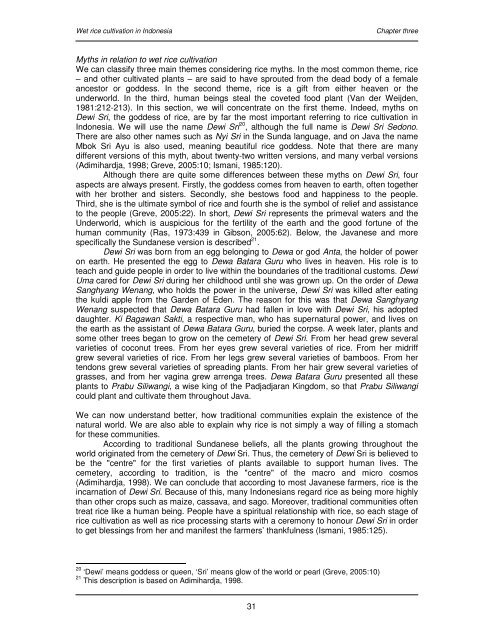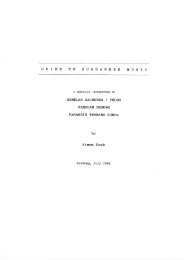Wet rice cultivation in Indonesia - Free EBooks Library
Wet rice cultivation in Indonesia - Free EBooks Library
Wet rice cultivation in Indonesia - Free EBooks Library
Create successful ePaper yourself
Turn your PDF publications into a flip-book with our unique Google optimized e-Paper software.
<strong>Wet</strong> <strong>rice</strong> <strong>cultivation</strong> <strong>in</strong> <strong>Indonesia</strong> Chapter three<br />
Myths <strong>in</strong> relation to wet <strong>rice</strong> <strong>cultivation</strong><br />
We can classify three ma<strong>in</strong> themes consider<strong>in</strong>g <strong>rice</strong> myths. In the most common theme, <strong>rice</strong><br />
– and other cultivated plants – are said to have sprouted from the dead body of a female<br />
ancestor or goddess. In the second theme, <strong>rice</strong> is a gift from either heaven or the<br />
underworld. In the third, human be<strong>in</strong>gs steal the coveted food plant (Van der Weijden,<br />
1981:212-213). In this section, we will concentrate on the first theme. Indeed, myths on<br />
Dewi Sri, the goddess of <strong>rice</strong>, are by far the most important referr<strong>in</strong>g to <strong>rice</strong> <strong>cultivation</strong> <strong>in</strong><br />
<strong>Indonesia</strong>. We will use the name Dewi Sri 20 , although the full name is Dewi Sri Sedono.<br />
There are also other names such as Nyi Sri <strong>in</strong> the Sunda language, and on Java the name<br />
Mbok Sri Ayu is also used, mean<strong>in</strong>g beautiful <strong>rice</strong> goddess. Note that there are many<br />
different versions of this myth, about twenty-two written versions, and many verbal versions<br />
(Adimihardja, 1998; Greve, 2005:10; Ismani, 1985:120).<br />
Although there are quite some differences between these myths on Dewi Sri, four<br />
aspects are always present. Firstly, the goddess comes from heaven to earth, often together<br />
with her brother and sisters. Secondly, she bestows food and happ<strong>in</strong>ess to the people.<br />
Third, she is the ultimate symbol of <strong>rice</strong> and fourth she is the symbol of relief and assistance<br />
to the people (Greve, 2005:22). In short, Dewi Sri represents the primeval waters and the<br />
Underworld, which is auspicious for the fertility of the earth and the good fortune of the<br />
human community (Ras, 1973:439 <strong>in</strong> Gibson, 2005:62). Below, the Javanese and more<br />
specifically the Sundanese version is described 21 .<br />
Dewi Sri was born from an egg belong<strong>in</strong>g to Dewa or god Anta, the holder of power<br />
on earth. He presented the egg to Dewa Batara Guru who lives <strong>in</strong> heaven. His role is to<br />
teach and guide people <strong>in</strong> order to live with<strong>in</strong> the boundaries of the traditional customs. Dewi<br />
Uma cared for Dewi Sri dur<strong>in</strong>g her childhood until she was grown up. On the order of Dewa<br />
Sanghyang Wenang, who holds the power <strong>in</strong> the universe, Dewi Sri was killed after eat<strong>in</strong>g<br />
the kuldi apple from the Garden of Eden. The reason for this was that Dewa Sanghyang<br />
Wenang suspected that Dewa Batara Guru had fallen <strong>in</strong> love with Dewi Sri, his adopted<br />
daughter. Ki Bagawan Sakti, a respective man, who has supernatural power, and lives on<br />
the earth as the assistant of Dewa Batara Guru, buried the corpse. A week later, plants and<br />
some other trees began to grow on the cemetery of Dewi Sri. From her head grew several<br />
varieties of coconut trees. From her eyes grew several varieties of <strong>rice</strong>. From her midriff<br />
grew several varieties of <strong>rice</strong>. From her legs grew several varieties of bamboos. From her<br />
tendons grew several varieties of spread<strong>in</strong>g plants. From her hair grew several varieties of<br />
grasses, and from her vag<strong>in</strong>a grew arrenga trees. Dewa Batara Guru presented all these<br />
plants to Prabu Siliwangi, a wise k<strong>in</strong>g of the Padjadjaran K<strong>in</strong>gdom, so that Prabu Siliwangi<br />
could plant and cultivate them throughout Java.<br />
We can now understand better, how traditional communities expla<strong>in</strong> the existence of the<br />
natural world. We are also able to expla<strong>in</strong> why <strong>rice</strong> is not simply a way of fill<strong>in</strong>g a stomach<br />
for these communities.<br />
Accord<strong>in</strong>g to traditional Sundanese beliefs, all the plants grow<strong>in</strong>g throughout the<br />
world orig<strong>in</strong>ated from the cemetery of Dewi Sri. Thus, the cemetery of Dewi Sri is believed to<br />
be the "centre" for the first varieties of plants available to support human lives. The<br />
cemetery, accord<strong>in</strong>g to tradition, is the "centre" of the macro and micro cosmos<br />
(Adimihardja, 1998). We can conclude that accord<strong>in</strong>g to most Javanese farmers, <strong>rice</strong> is the<br />
<strong>in</strong>carnation of Dewi Sri. Because of this, many <strong>Indonesia</strong>ns regard <strong>rice</strong> as be<strong>in</strong>g more highly<br />
than other crops such as maize, cassava, and sago. Moreover, traditional communities often<br />
treat <strong>rice</strong> like a human be<strong>in</strong>g. People have a spiritual relationship with <strong>rice</strong>, so each stage of<br />
<strong>rice</strong> <strong>cultivation</strong> as well as <strong>rice</strong> process<strong>in</strong>g starts with a ceremony to honour Dewi Sri <strong>in</strong> order<br />
to get bless<strong>in</strong>gs from her and manifest the farmers’ thankfulness (Ismani, 1985:125).<br />
20 ‘Dewi’ means goddess or queen, ‘Sri’ means glow of the world or pearl (Greve, 2005:10)<br />
21 This description is based on Adimihardja, 1998.<br />
31








